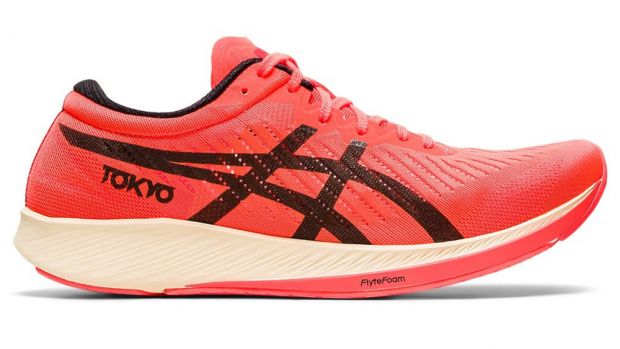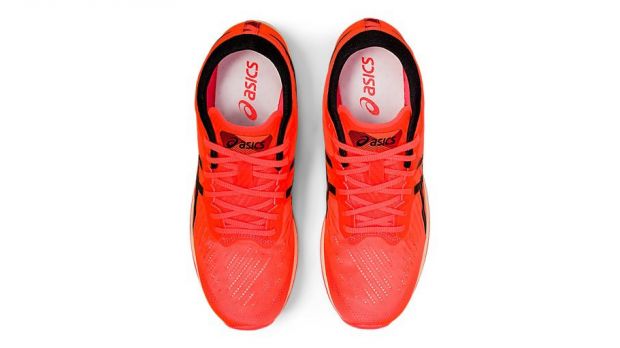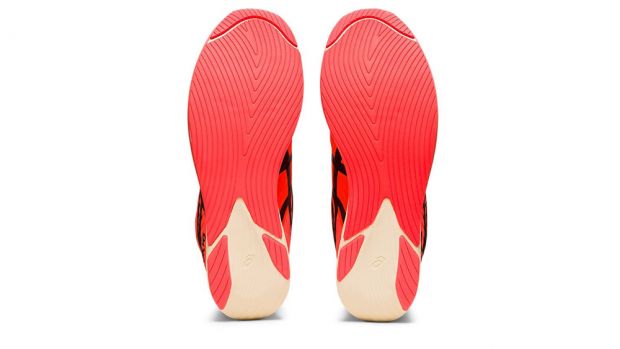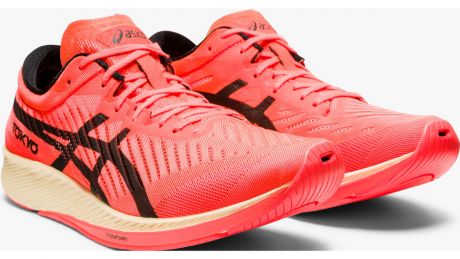Our Verdict
With less cushioning and a firmer ride than most carbon shoes, the Metaracer might work for runners who dislike soft, high-stack racers, but it doesn’t match the speed or efficiency gains of true super-shoes.
For
- Great ground feel
- More protection than a racing flat
Against
- Harsher ride than high-stack shoes
- Midsole foam lacks bounce
- Carbon plate under forefoot only
You can trust Coach
While every running shoe brand has been playing catch-up with Nike since the launch of the Vaporfly 4%, not all of them are following the Vaporfly (and now Alphafly) blueprint when creating their own racing shoe with a carbon plate in the midsole.
The Asics Metaracer, for example, has very little in common with the Vaporfly aside from the carbon plate. Even in that regard it differs in that the plate is under only the forefoot of the shoe and placed beneath the midsole foam, rather than a full-length plate placed within the midsole.
Asics’s Flytefoam cushioning, which is lightweight and durable, is also nothing like as soft and springy as the foam found in rival super shoes like Saucony’s PWRRUN PB, New Balance’s FuelCell or Nike’s ZoomX. The stack height is also much lower in the Metaracer at 24mm, whereas other shoes are going close to the 40mm limit imposed by World Athletics in response to records tumbling to athletes in high-stack shoes.
This relative lack of cushioning means the Metaracer Tokyo is lighter than shoes like the Nike Alphafly and Saucony Endorphin Pro, which come in around 230g for my UK 9, while the Metaracer is 210g. That said, the Vaporfly Next% is 198g in a UK 9, so there are lighter high-stack options with a carbon plate.

The Metaracer does earn its weight, though. A notably thick slice of rubber on the outsole, coupled with the durable Flytefoam cushioning used, should mean it lasts longer than other super-shoes. If you’re reserving it for fast runs and races – which you will be because it’s not all that fun to run easy miles in – you will have your speed shoe sorted for several race cycles.
As with other Asics shoes like the Glideride and Evoride, the Metaracer uses Asics’s Guidesole tech to roll you from heel to toe, promising to reduce ankle flexion and the demands on other muscles. I found the rocker felt far less pronounced in the Metaracer than in the other Asics shoes, which is no bad thing because it results in a more natural feel to the ride.
The Metaracer sounded very promising on paper, offering a few super-shoe benefits in the shape of a carbon plate, extra cushioning and the Guidesole rocker, while still being lightweight and feeling like a racing flat. I hoped it could provide an alternative, but equally good, racing option to high-stack shoes like the Vaporfly – but while it is certainly different, I wouldn’t say it’s as good for longer events like half marathons and marathons.
While the Endorphin Pro, Vaporfly and Alphafly all feel like they make running at a fast pace significantly easier and more sustainable, I didn’t feel much in the way of efficiency benefits from the rocker in the Metaracer, and the ride is much firmer and less springy.

However, it’s undoubtedly a quick shoe, and I loved using the Metaracer for interval sessions. I used it for a tough session of 400m and 800m reps in torrential rain (thanks, British summer), plus an interval workout of 20 x 60sec on, 30sec off. It felt great for both, and I do think the extra cushioning plus the plate means your legs are fresher at the end of hard runs compared with a racing flat.
It will be a great 5K and 10K shoe, I’d say, but on tempo and long runs it was harder on the legs and less fast than the other shoes in its class. You could race a marathon in the Metaracer, but it wouldn't protect your legs in the same way as others. Only lightweight runners used to racing flats would really enjoy the experience of using the shoe for the full 42.2km.
One major benefit the Metaracer does offer is grip in wet conditions. The rubber on the outsole never failed to find purchase on my runs, even in that rainy interval session. Over a twisting 5K route in the rain it might well have the edge over shoes like the Alphafly, which is less stable.
See related

The main problem with the Metaracer is not the Metaracer itself – it’s not a bad shoe by any means. It’s very fast and more cushioned than a traditional racing flat, and also boasts an absolutely gorgeous design. However, right now I think the shoes coming out from Nike and Saucony in particular offer more benefits for long-distance racing. The Endorphin Pro is only £10 more and a slightly better all-round shoe; it’s even more comfortable for easy runs if you do want to use it for everything.
There might be a market for the Metaracer among runners used to racing flats who don’t want to change to a soft, high-stack shoe. I love a shoe with a high stack so would probably reserve the Metaracer for speed sessions and short races, but it’s good to have another carbon plate option available that offers a more traditional feel.

Nick Harris-Fry is a journalist who has been covering health and fitness since 2015. Nick is an avid runner, covering 70-110km a week, which gives him ample opportunity to test a wide range of running shoes and running gear. He is also the chief tester for fitness trackers and running watches, treadmills and exercise bikes, and workout headphones.

